Kumana National Park is in Eastern Province of Sri Lanka.
Kumana National Park became an independent wildlife sanctuary in 1969, with not much of an evidence that showed the history of the large landmark. Kumana, before it was named as a sanctuary, was a great hunting ground for elephant poachers and zoo keepers from Dehiwala who wanted the animals to be presented at their zoo. The only evidence of what remains in cultural aspects is the Tamil Kovil which supports the pilgrimage foot tour known as the pada yatra(pronounced Pardha Yarthra). But what shows the most interest in the park are the old cave drawings believed to have done by the Veddas. These cave drawing represented a group of hunters and heard of wild elephant. Some say that the park was once home to the Lankan legend called Nittaewo. A race of short dwarves who lived in the country many years ago.
In 2006, the park that had been named 'Yala-East Park' was renamed "Kumana".
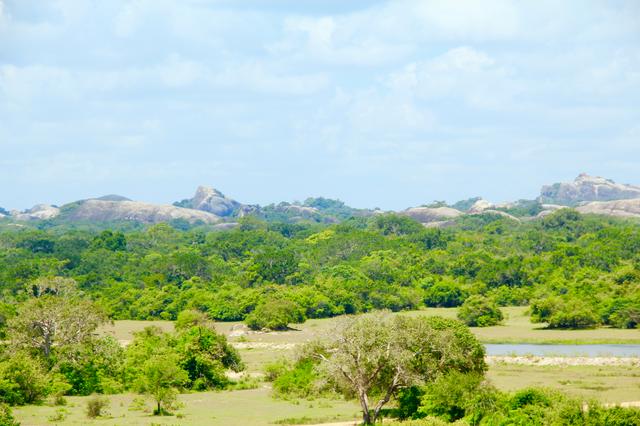
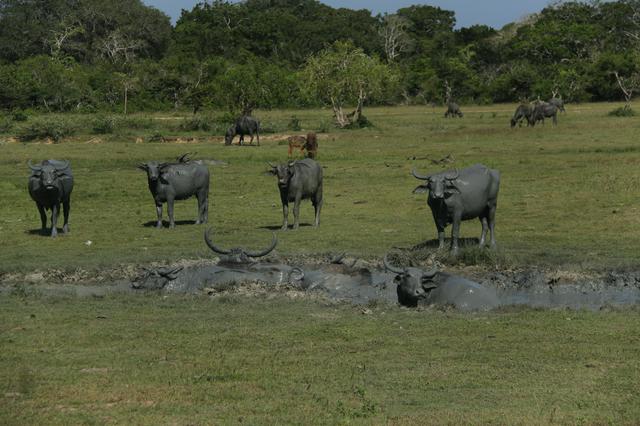
- The park covers and is home to over 255 bird species. Its wild landscape is known for its animal diversity, with over 20 tanks all over the park, Kumana Wildlife Sanctuary is known to be the largest bird sanctuary in Sri Lanka. The park is fairly flat but some mountainous structures can be seen from place to place. The park is mostly covered with wide plains, thick forests and the afore mentioned water bodies. Civilization or manmade structures are quite rare in the park, apart from a few ancient buildings built for the tamil pilgrimage walk.
The dry zone rain forests are surrounded by dry tropical thorn forests. The park's most dominating plant is Manilkara hexandra, known as 'Palu' by the local Sri Lankans. Forms of algae influence water beds inside the park. The trees are usually dry and weak due to the lacking of minerals and water.
Kumana national park's main specialty is it's vast diversity of animal species, and it is also a reason for it's seperation from Yala National Park.
Kumana Bird Sanctuary is included in the national park. Kumana is the most important breeding and migrating ground for the birds in Sri Lanka. From the month of April to the month of July, thousands of birds migrate and breed in the area, Very rare species, such as the black necked stork, which cannot be found elsewhere in the country, use Kumana as their main migrating stop and breeding grounds. the reason for the vast consensus of birds is the perfectly compatible landscape for breeding.
Even though mammals are present in the park, many can rarely be seen to the visitors. The frequently seen mammals can be simply put forward as deers, elephants and wild boar. Other than that, many other shy mammals such as golden Jackals and European otters exist within the park. Elephants- Are usually seen bathing in the water beds of the park, sometimes they can also be seen in deep thorny bushes. Deers can usually be seen as groups in the open areas of the park. As it was a part of the Yala National Park, there are chances that you might see a Sri Lankan Leopard.
Reptiles such as the mugger crocodile can usually be seen near water beds throughout the park (mostly recorded at noon). Indian flap shelled turtles and indian black turtles also exist in the park. Apart from reptiles fascinating varieties of butterflies and fish can be seen inside the park as well.
Kumana National Park has a persistent dry climate where heavy rainfall is uncommon, but can be expected during the south-western monsoon season (May–September). From December to March, Kumana receives dry winds coming from the northern parts of the country. The average temperature of this area is about 33 °C (92 °F), and the humidity percentage is about 58%.
Kumana National park is a national treasure of Sri Lanka, and certain rules apply when touring the park. The visitors who damage the natural formations of the park will be prosecuted, whilst Constant littering and picking fruits from trees are not allowed. The park management severely respects the privacy of the animals. Bothering them or scaring them from their own habitats is prohibited.
Permits are not needed to enter the park, but you must carry your passport and identification just in case.
The average fee for a foreign child from the ages 6 to 12 years is approximately US$5, it would take the fee of Rs. 20 for a local child. The service charge is US$8. Carrying some extra money will help you as well.
Kumana as a national park does not have any special places for tourism, but interesting rituals such as the Pada Yathra is a spectacular moment to see. It is a group of Hindu pilgrims walking from Jaffna to Katharagama. Near the park there is a small Hindu Kovil, which was built for the pilgrimage to stop during their journey. You can go there and refresh yourself or appreciate the art of the Hinduism structures.
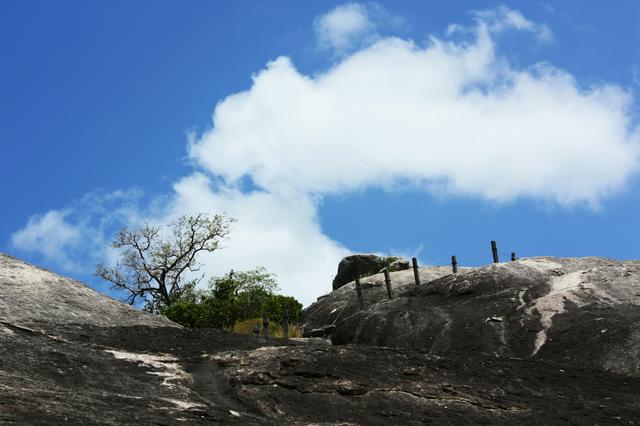
- Kudumbigala sanctuary, +94 77 697 7417.
- Uganthai Malai Murugan Kovil. The nearest kovil/relief zone from Kumana National Park.
Kudumbigala sanctuary, +94 77 697 7417.
Uganthai Malai Murugan Kovil. The nearest kovil/relief zone from Kumana National Park.
It is essential to bring equipment and cloth wear to an outing. Given below are some equipment and clothes wear that you can bring on the trip
- Cash/Currency – It is important to bring money on a trip, it would be needed in case of emergencies such as medical treatments.
- Medicine – Medication is required in a long trip, especially safari's. You must pack a medication pill called Panadol (paracetamol) which can be used as a remedy for Headaches and fever. It can also be used for tooth-aches.
- Ointments – An ointment that would repel snakes and mosquitoes (recommended: Siddhalepa).
- Watch – if you are on a tight schedule.
- Phone – for emergencies.
- Snacks – a small pre-food would be good. (eg- a tin of biscuits, finger sandwiches, batter cake)
- Sun lotion – to avoid getting sun burnt.
- Binoculars – to see animals from a distance (increases safety and lessens tourism impact).
- Camera – to capture the scenic environment
- Notebook – to write down observations and notes, maybe even lodge data of your trip.
- A field guide – to identify animals in the park.
- You must wear loose clothing, and such that would blend into the environment. You must bring either a cap or a hat as it is frankly sunny there. You must wear shoes or boots for your own safety. Shorts would be the best choice for a trip in the dry zone which is bound to continue for several hours.
- Bird-watching – With over 255 bird varieties, the Kumana National Park is the ideal place for bird-watching. Even though endemic birds are rare in the parts, you surely will spot quite unique birds. Especially waders who visit the tanks of Kumana regularly
- Zoology – Kumana is home to many species of animals, not only can you study them, you can also see their regular activity and days work. All you need is a pair of binoculars and optionally a video camera.
- Dendrology – Many varieties of trees are present in this giant park. This would be a great opportunity for tourists to study endemic plants to Sri Lanka as well. The Fauna has a wast diversity in the area.
- Archaeology – Explore the History of the greatest animal sanctuary in Sri Lanka. See the oldest cave drawings and inspect some of the greatest rituals done by the Hindu pilgrims in Sri Lanka.
Bird-watching – With over 255 bird varieties, the Kumana National Park is the ideal place for bird-watching. Even though endemic birds are rare in the parts, you surely will spot quite unique birds. Especially waders who visit the tanks of Kumana regularly
Zoology – Kumana is home to many species of animals, not only can you study them, you can also see their regular activity and days work. All you need is a pair of binoculars and optionally a video camera.
Dendrology – Many varieties of trees are present in this giant park. This would be a great opportunity for tourists to study endemic plants to Sri Lanka as well. The [[Kumana National Park#Fauna|Fauna]] has a wast diversity in the area.
Archaeology – Explore the [[Kumana National Park#History|History]] of the greatest animal sanctuary in Sri Lanka. See the oldest cave drawings and inspect some of the greatest rituals done by the Hindu pilgrims in Sri Lanka.
- A small store is included in the main entrance of the park, there you can buy equipments such as pocket guides, souvenirs and snacks for the trip. Other than that the only other shops that can be found are in the village nearby. Things required for the trip can be bought in the supermarkets in Arugam bay. Recommended super-markets are Keels and Cargils. If you do not find any of these super-markets, ask your hotel manager for a trusted store in the area.
Eating is necessary as the tour will at least take an hour. If you are bringing a snack, bring it wrapped in a decomposing paper material. There are no restaurants or snack bars inside the park and picking fruits from trees is prohibited. The most suggested food item is box of sandwiches (finger sandwiches is the best choice). Taking no food will leave you starved unless you ask the driver to return midway. You can always purchase food from stores before coming to the park.
It is necessary to bring along a water bottle. You can buy small drinks at the entrance shop, you can also buy drinks from the Kumana Village. You must stay hydrated during the trip since as you could catch a dry throat. Packing a cool drink in a thermos would be a very helpful move. Hot drinks such as tea is not the best option in a dry zone. Drinking water from tap lines in uncivilized areas is not such a good idea. Apart from water, you can purchase refreshments from the nearest supermarket or roadside stores.
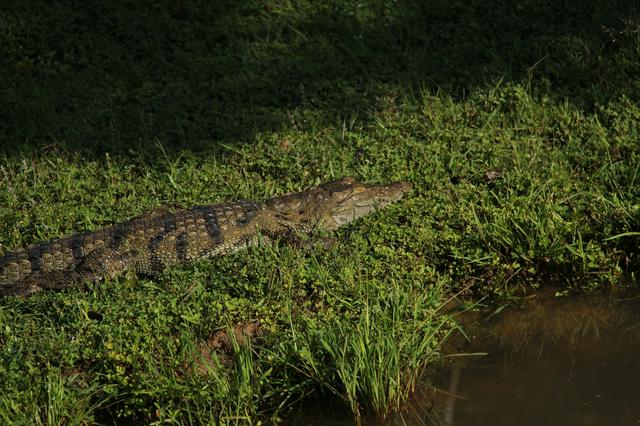
The park compared to its size has many dangers around every corner. Implementation without the driver's guidance is not suitable for your safety. Also as a wildlife sanctuary, the animals in there are a threat to visitors just like we are a threat to them.
Wild elephants – Sri Lanka is well-known for its elephants, and in a national park, you will be sure to spot one. But when you do, you must stay inside the vehicle at all times. You must only get out if the elephant is over 200 feet (60 m) away from you. Unlike some of the tourist spots in Sri Lanka, feeding is not an option. This would just cause more trouble.
Crocodiles/alligators: – The park has over 20 tanks in the interior. Almost 16 of these tanks are infested with giant crocodiles. One wrong move and you will be in big trouble. An average crocodile has a 16,460 newton bite force and it could rip into meat with a force of 890 newtons. This is one of the reasons for a vehicle tour and the application of the 'stay in the vehicle at all times' rule.
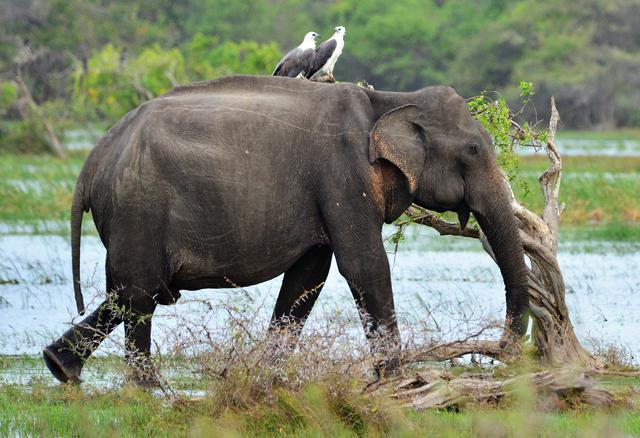
Wild buffaloes – Wild buffaloes are not that hostile to visitors, but there are chances that they would dislike being disturbed. Their horns itself can damage half of a human body and it's kick might even permanently disable you.
Snakes and other reptiles – Snake bites are pretty uncommon in these area's, but just in case you see tall grass, do not go in ... and do not go too far into the forests. A bite is not helpful when you are in the middle of a dry land forest far from a hospital.
Apart from threats by wild animals, there is a very rare chance of getting lost. hence, it is advised that you keep your cell phone with you at all times. If you are tagging along children on this trip, do not let them wander off whenever you have made a stop, and whilst riding through the park, do not let your children lean over from the railings of the truck, because it holds a high risk of falling overboard.
In case of a medical emergency, dial 110. If you do not have any reception, you can simply ask the driver to turn around the vehicle. It would be best if you bring along a bag of simple medication (antibiotics and etc...).
If you want to report any other emergency, focusing on a very important situation, dial 119 or 118.
